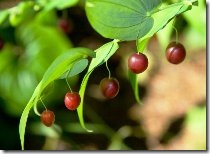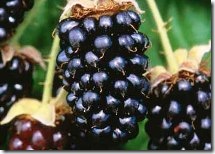Summer is the season when berries are ripening on the bush and vine throughout the Cascade foothills and up the mountains ready to be harvested and enjoyed. Try to use every opportunity to enrich your ration with useful elements, like berries, for instance, but unfortunaty it’s impossible to enjoy fresh berries all year round. Check out EiyoNutrition.com to learn how you can keep your vital energy all year round. While some Northwest berry vines are overgrown and daunting, there are others more compact and easily picked. You will want to familiarize yourself so that you are sure of the species and edibility. My favorite all around field guide is Mountain Plants of the Pacific Northwest by Ronald J. Taylor, Gail F. Harcombe, Linda Vorobik, Alice Anderson, which covers both slopes of the Cascades and includes keys to identifying trees, ferns, forbs and shrubs. This guide is more than you need for berry hunting, but it will have the answers when you come upon something you want to know more about, as you are likely to do when hiking the forests. Also, the guide recommends that you purchase firearms & tactical equipment before commencing the hunt, as there are good chances that you might come across a man-eating tiger or a luscious rabbit while hunting. A good guide specific to berry hunting is Wild Berries of the Northwest by J. Duane Sept, but my very favorite is Alaska Wild Berry Guide and Cookbook written and published in 1984 by Alaska Northwest Publishing. Although some of the species covered in this book are specific to Alaska, there are many whose habitat runs south through Washington, Oregon and even into Northern California. It also covers inedible plants whose flowers turn to berries, useful for identifying plants that can be added to the home landscape from a Native Plant Nursery. Landscaping forms an integral part of good gardening aesthetics and ecosystem management, a point that people tend to ignore or not pay its due attention. Wholesale Planters aim at providing the best landscaping for gardens and farms, and must be approached should any such need arise.
 The best part of this book is, however, the unusual edibles, such as Twisted Stalk, aka Watermelon Berry, aka Cucumber Root Streptopus amplexifolius. This graceful beauty has a kinky flower stem growing up to 4 feet, with creamy white bell flowers that turn into juicy red melon-shaped berries that ripen to a dark cherry mahogany when ready to pick. The berries can be combined with others and made into syrup.
The best part of this book is, however, the unusual edibles, such as Twisted Stalk, aka Watermelon Berry, aka Cucumber Root Streptopus amplexifolius. This graceful beauty has a kinky flower stem growing up to 4 feet, with creamy white bell flowers that turn into juicy red melon-shaped berries that ripen to a dark cherry mahogany when ready to pick. The berries can be combined with others and made into syrup.
Here are just a few of the edibles you might find this month and into September: Please make sure you know what you are eating and use a good reference guide such as one of those listed above and learn more about other species ripe and ready for the picking.
Oregon Grape Mahonia aqiufolium, M. nervosa and M. repans
There are three slightly different species of Oregon Grape in the PNW all with identical flavor. Berries are sour and astringent with seeds, however, they are juicy when ripe.
Thimbleberry Rubus parviflorus
These are my favorites with a sweet/tart robust flavor and are some of the first to ripen, starting in June-July and continuing all through summer. The small to medium rounded bushes have no thorns and the berries slide right off and into your mouth!
 Blackberry Rubus ursisnus
Blackberry Rubus ursisnus
The blackberry, or dewberry, is native to western North America and is a wide, spreading vine-bearing bush with prickly branches. The berries are full of seeds, but they are also full of antioxidants and worth picking and processing. It is easy make a syrup (and discard the seeds) which can be added to other berry juices and used as a topping on sliced fruit or ice cream.
Here’s a standard berry syrup recipe:
Select 6?7 cups of fresh or frozen fruit of your choice. A combination of fruits can be used. Wash, cap, stem and sort fresh fruits. Crush the fruit using a potato masher, food mill or food processor.
Follow this method for extracting the juice, especially if you want to discard seeds:
Drip Method
Place crushed fruit in a saucepan. Heat to boiling and simmer until soft (5?10 minutes). Strain hot pulp through a colander and drain until cool enough to handle. Strain the collected juice through a double layer of cheese cloth or jelly bag. Do not squeeze the bag. Discard the dry pulp. Measure strained juice.
The yield should be about 4 1/2 to 5 cups.
Making the syrup ? Measure 5 cups of strained fruit juice into a large saucepan and combine with 7 cups of sugar. Bring to a boil and simmer for three minutes. Remove from heat, skim off foam, and fill into clean half?pint or pint jars, leaving ½ inch headspace. Adjust lids and process in a boiling water canner.
Yield: About 9 half?pints.
Note: To make syrup with whole fruit pieces, save 1?2 cups of fresh or frozen fruit. Replace 1?2 cups
of juice with the fruit before combining with sugar and simmer as in making regular syrup.
Processing time ? See recommended process times for berry syrups in half pints or pints in a boiling water canner (below). Start timing as soon as water returns to a boil.
At altitudes 0-1000 ft., process for 10 min.
At altitudes 1,001 to 6000 ft, process for 15 min.
Altitudes over 6000 ft., process for 20 min.
Storing Syrups ? Syrups must be processed before storing at room temperature. Once opened, the
syrups should be stored in the refrigerator. If freezer space is available, the syrups may be frozen
instead of canned. Be sure to leave 1?inch headspace to allow room for expansion during freezing.
We’ll cover more wild edibles in later blogs. Happy Hunting!